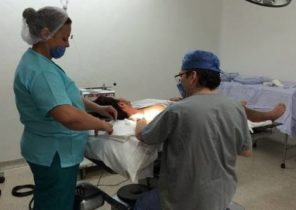23 Jul Chinese probe “Tangwani-1” Mars exploration was successfully launched into a transfer orbit and started its journey to the red planet.
This year is “fruitful” in terms of Mars exploration: the UAE, China and the United States consistently has launched probes to Mars. As the planet that is closest to the Earth and has the most similar environment, he has always been a subject of considerable attention in the process of human exploration of space. Especially after the end of the cold war, when USA and the Soviet Union ceased to have a monopoly on sounding of Mars, more and more countries joined the research. In this article The Paper will talk about the state and future of Mars exploration in different countries and organizations.
In March this year the European space Agency (ESA) and the Russian state Corporation “Roskosmos” has announced that the initial joint plan for the launch of the “ExoMars-2020” (ExoMars2020), which was to be implemented in July, has been postponed until 2022. The reason is that two parachutes required for soft landing on the surface of Mars, still not finished testing and examination.
Mission “Eczemas-2020” is a joint program of the European space Agency and Roscosmos on the exploration of Mars. In the “ExoMars-2020” Russia is responsible for the development of the landing platform Kazachok, some of the scientific instruments and the rocket, and the ESA is mainly engaged in the Rover “Rosalind Franklin” and some scientific instruments.
After the failed launch probe to study Mars “Phobos-Grunt” in 2011, the already limited capacity of Russia in the exploration of deep space was blocked: she not only couldn’t continue independent research of the red planet, but even stopped their moon program. In these circumstances, the search for international cooperation is a wise decision.
Becoming the successor to the Soviet Union, Russia has also “inherited Soviet bad luck”
9 November 2011 from Baikonur cosmodrome in Kazakhstan was launched a carrier rocket “Zenit-2ЅБ” with interplanetary station “Phobos-Grunt”. Due to the fact that the goal of the “Phobos-Grunt” was to take soil samples on Phobos and return back to Earth, and delivery of such international goods, like Chinese micro-satellite “inkho-1”, American experimental device to test the interplanetary flight of living organisms and Finnish MetNet landing gear, in that year, the space launch was the most anticipated. However, a few hours after launch, Roskosmos announced that the probe is faced with a contingency, because the main engine does not work, and AMC was unable to leave earth orbit.
According to the plan, “Phobos-Grunt” was to land on the surface of Phobos, satellite of Mars, and after taking soil samples to return to Earth. If this mission were implemented, humanity would for the first time conducted a field study companion another planet, and implementation of soil sampling would help people better understand the process of the formation and evolution of Mars. In addition, it could provide new evidence for the existence of life on other celestial bodies. Why, then, target was a satellite of Mars, not the Mars? This is due to the fact that the technology of sampling on the satellite of Mars is much easier than on the planet itself, and the costs are also lower. The moons of Mars do not possess the identical atmosphere and gravity was less also.
The failure of the mission “Phobos-Grunt” not only disrupted the exploration of Mars, but also led to the failure of international cooperation projects. It is also the second failure of the Russian project for the sensing of Mars (not including the Soviet project) after the project “Mars-96”. These two failures are no doubt a huge blow for Russia.
The probe “Mars-96” weighed 6.7 tons and consisted of the Orbiter for long-term studies in orbit, two small Autonomous stations, and two shock penetrating probe. After landing on the surface of Mars, he mostly had to study the Martian climate, composition, surface features, magnetic field and seismic conditions. Penetrators were intended for introduction into the Martian soil and study the important information, such as its chemical composition and moisture content. The mission was also a project of international cooperation, which was attended by research institutions from USA, France, Germany and the UK, providing some scientific instruments and equipment.
The project “Mars-96” was worth about $ 1 billion and took almost 10 years. The probe was launched on 16 November 1996 and crashed in the South Pacific ocean on November 18. Thus, the mission failed.
The failure of the mission “Phobos-Grunt” adds another example of the tragic history of Soviet-Russian exploration of Mars. Since the launch of the first Mars Rover “Mars-1A” in 1960, the Soviet Union and Russia was held on 19 attempts at probing Mars, of which only two were fully successful (mission “Mars-2 and Mars-3”, referring to the orbital apparatus), thus the success of missions to study Mars is only 10%. Even adding three partially successful mission (“Mars-5” and “Mars-6” and “Phobos-2”), the success rate is only 26%. A high percentage of failures even gave the world the space to joke about the fact that “Mars belongs to Russia”.
Whether Kazachok dance on Mars?
After the end of the cold war, although Russia began to attach great importance to international cooperation in the exploration of Mars, but she wanted to lead the project and showed enthusiasm for missions led by others. After the failure of the “Phobos-Grunt” Russia has radically changed their attitude and showed enthusiasm for the mission “ExoMars”, headed by ESA, and finally, in 2013 an agreement was concluded.
In accordance with the European-Russian agreement, the mission “ExoMars” will use the rocket “proton-M” for two-stage delivery of research equipment on Mars: the first stage is called “ExoMars-2016”, and ESA was launched with “the Orbiter for the study of small components of the atmosphere” (TGO) and the experimental lander “Schiaparelli” (EDM), carrying two Russian scientific instruments. The second stage is called “Eczemas-2018”. The Rover of the ESA “Rosalind Franklin” (Rosalind Franklin), and a landing platform Kazachok planned for launch in 2018 (later than the launch was postponed to 2020, and the name of the mission, respectively, was also changed to “Eczemas-2020”).
Lander Kazachok, which is responsible for developing Russia is not only the landing platform for the Rover, and a platform for scientific experiments. “Kazachok” literally means “little Cossack”, and a very vigorous folk dance. Developed by ESA, the Rover has received the name “Rosalind Franklin” — it is named after the famous scientist who discovered the structure of DNA. Once it reaches the surface of Mars, the Rover will separate from the “Cossack” for their own scientific research, while the landing platform will not know about his whereabouts and engaged in scientific research at the landing site.
The landing platform Kazachok weighs about 827,9 kg and has a design life of 1 year. It includes 11 Russian and 2 European instrumentation. The weight of scientific instruments is 45 pounds. The apparatus is designed to study the environment of Mars and analysis of the Martian environs near the landing site, including long-term monitoring of climate, atmosphere, terrain, radiation, internal surface structure, distribution of groundwater and exchange of volatile substances between the atmosphere and the surface around the landing site. The Rover is equipped with 7 European and 2 Russian instrumentation, and it will accomplish the mission on a long journey of several thousand meters, to assess the geological landscape and the microscopic composition of the red planet. His two-meter drill will try to dig up the elements of biological life, buried under the surface of Mars.
Because of the relatively large weight of the “ExoMars-2020” was developed for it is very difficult the design of a parachute. This is the main reason why the launch mission was postponed until 2022. “Eczemas” uses two sets of four parachutes. After entry at first will be revealed the first set of spare parachutes, after some time they will be disconnected and will be revealed the first set of the main parachutes, which will also be disconnected. After that, the same way will be revealed the second set of spare parachutes, and after disconnecting the second set of basic parachutes. The large main parachute has a diameter of 35 meters, and today it is the largest Martian parachute. Such a complex planting scheme also increases the technical risks of the “Eczemas”. Will Russia, with the Soviet space legacy, to say goodbye to the “Martian artist of the USSR”, we all still have to learn.







